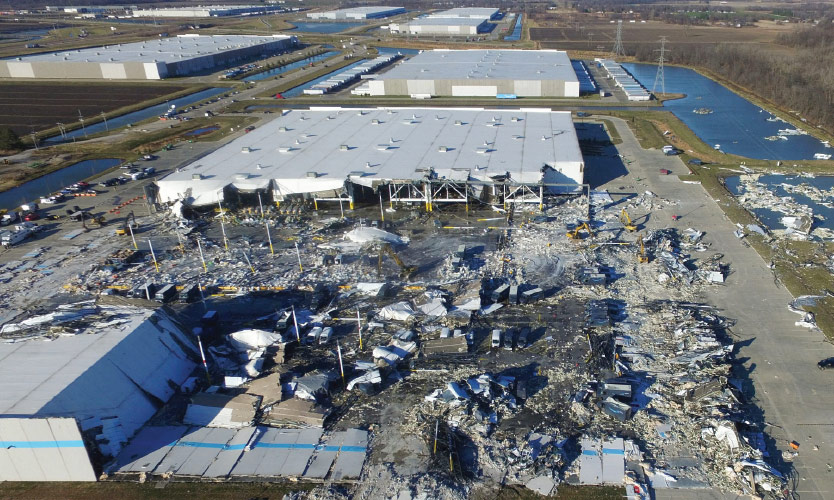Natural disasters call for employers to have in place detailed plans to keep workers safe in an emergency, yet some organizations — either through lack of foresight or lack of training — often fall short of this federal requirement, according to risk experts.
“I don’t know that they’re shirking it so much as they’re not thinking through all the risk factors and not doing a good risk evaluation,” said Christine Sullivan, Glastonbury, Connecticut-based president of the American Society of Safety Professionals. “If you talk to C-suite professionals in companies that have very strong safety programs, one of the things that I always find interesting is what was their ‘aha’ moment? What was it that said, ‘This can happen to us’?”
The Occupational Safety and Health Administration, under its General Duty Clause, requires employers to create an emergency action plan that provides strategies on what to do in an emergency, covering such issues as evacuation and shelter-in-place protocols. The plan must cater to a facility’s unique risks and should come with ample training, experts say.
“An employer’s emergency action plan is often “‘Oh, we’ll deal with that situation when it happens,’” said Jay Gnadt, a Dallas-based senior vice president for risk control consulting at Lockton Cos. LLC. “Well, in a real disaster-imminent situation, there’s not time to formulate a plan when the tornado is approaching, or a flood or whatever it may be.”
<a rel="gallery" class="fancybox" href="http://www.businessinsurance.com/assets/pdf/BI_0722_05.png"><span class="rsrch_img" style="background:white !important; width: 480">
<img src="http://www.businessinsurance.com/assets/pdf/BI_0722_05.png" width="480"></span></a>
When a string of tornadoes hit the central United States in December 2021, at least two organizations were forced to face possible lapses in their emergency action plans.
Amazon.com Inc. was investigated by OSHA following an EF3 tornado on Dec. 10 that leveled part of a warehouse in Edwardsville, Illinois, and killed six workers. On April 26 of this year, OSHA said it would not cite Amazon, finding no cause for violation of a specific OSHA standard.
However, it identified three issues with the company’s emergency action plan: a megaphone that was part of the facility’s plan to notify workers of a hazard “was locked in a cage and not accessible”; some workers “could not recall the location of the … designated severe weather shelter-in-place” area; and the plan was “not customized with specific instructions associated with the anticipated hazards expected for this facility and it contained elements that would not be encountered in Edwardsville, IL, such as a hurricane,” and because of that “(t)he plan did not specifically identify the location of the designated shelter area for the facility.”
In response to a request for comment, an Amazon spokeswoman said the “tornado that hit our delivery station was extreme and very sudden, with winds that were much like the force of a category 4 hurricane, and we believe our team did the right thing.”
“OSHA’s investigation did not find any violations or causes for citations, but we’re constantly looking to innovate and improve our safety measures and have already begun conducting additional safety and emergency preparedness drills at our sites and will carefully consider any OSHA recommendation that we have not already,” the spokeswoman said.
Also on Dec. 10, a Mayfield Consumer Products LLC candle manufacturing facility in Mayfield, Kentucky, was hit by an EF4 tornado, killing nine workers. Kentucky’s Occupational Safety and Health Program division is investigating the event, and several workers filed a class-action lawsuit in March claiming supervisors “repeatedly threatened to terminate the employment of any employee who left (the facility) because of the expected tornado” of which they had a three-hour notice.
Troy Propes, CEO of Mayfield Consumer Products, said in a Dec. 14 statement the company was “immediately retaining an independent expert team to review the actions of our management team and employees on the evening when a tornado struck our facility.” The company had heard accounts from a few employees that its procedures were not followed, despite having an emergency plan in place, Mr. Propes said.
Safety experts declined to discuss the December incidents. However, they say shortcomings in plans are common.
“I have seen a lack of emergency action plans in the workplace. And I’m working with several clients right now who are in the middle of rewriting or buffing up their plans just to help make them stronger,” said Marc Hindman, Alpharetta, Georgia-based risk control and claims advocacy practice leader for Willis Towers Watson PLC.
Andrea Ball, Orlando, Florida-based assistant vice president and senior casualty specialist for Sompo International Risk Control Services, said complacency is seen “in every aspect of safety,” but natural disasters are one area that warrants more attention.
“The ‘it’s not going to happen to me’ is absolutely a mindset that people get into” when it comes to weather-related issues, she said, adding that lack of ample training is a common pitfall.
“We need to have these plans in action. Because when this does occur, and it will eventually occur, people need to be ready,” Ms. Ball said. If nothing occurs, companies can count that as a drill and say, “OK, we had a live drill. We went through all the steps. How did we do?” she said.
From there, a company can use that data to make its next round even better, because “the next round that EF2 tornado could be an EF4, and it could be catastrophic,” she said.
<BR><HR>
Climate change-driven disasters heighten need for emergency protocols
Changing weather patterns are prompting more companies to focus on emergency protocols.
Jason Mumbach, Norwalk, Connecticut-based senior vice president for property risk control and emergency management at Marsh LLC, said, “There are instances where employers don’t have these procedures in place, and they’re starting to focus on them because they get hit with a natural disaster that is not common to their area.”
Mr. Mumbach cited the example of Hurricane Sandy, which caused destruction in the Northeast in late October 2012. “You’re used to seeing hurricane damage in Florida and all of the Gulf Coast, not typically that far north that late in the season,” he said.
“You’re starting to see natural disasters happening in areas of the country that maybe they weren’t happening in the past, because of things like climate change,” said Christine Sullivan, Glastonbury, Connecticut-based president of the American Society of Safety Professionals.
The pandemic may also have helped raise awareness of unforeseen risks, experts say.
“There is an increased interest among clients to strengthen their emergency action plans, said Jay Gnadt, a Dallas-based senior vice president for risk control consulting at Lockton Cos. LLC. “We’re having a lot of conversations and discussions and meetings about risk identification, threat and risk assessments on a site-specific basis. We’re doing that now much more frequently than we were five years ago.”
“If you look at what just happened with COVID, a lot of companies were not prepared for what was happening,” Ms. Sullivan said. “I know that was not a natural disaster, but it has in many ways caused (companies) to rethink how they work.”



